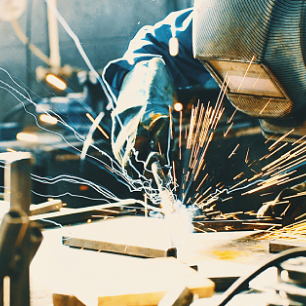Jump to:
Conventional and Emerging NDE Techniques for Amusement Parks
Nondestructive examination (NDE) of amusement park infrastructure is critical to safely operating the broad spectrum of rides. Most amusement park infrastructure is fabricated from structural steel to AWS D1.1, Structural Welding Code — Steel, or comparable ride manufacturer specifications. Amusement park infrastructure includes everything from massive roller coaster to smaller lap bars and pins. Many components are coated with very thick coatings and foams, preventing direct visual testing (VT). Additionally, many components, like gears and pins, are coated with grease, inhibiting NDE. Consequently, NDE of amusement park components often requires the removal of coating or foam and degreasing before performing VT, magnetic particle inspection (MT), and liquid penetrant testing.
Some advanced NDE techniques, such as eddy current testing (ET), eddy current array (ECA) testing, and alternating current field measurement (ACFM), show potential for inspection with limited surface preparation.
Qualified personnel perform NDE on chassis, axles, bogies, and tracks. The inspection objectives are to identify in-service cracks and metal loss due to wear or corrosion, and NDE professionals accurately locate and quantify the extent of discontinuities and material defects — Fig. 1.
Visual Testing
VT is the first line of defense for all amusement park infrastructure, including welds, small, redundant parts, and large, complex components. Based on over 15-plus years of amusement park NDE experience, I have found that more than 80% of all indications can be identified through thorough VT. A NDE inspector can identify most of the damage mechanisms encountered on the amusement industry’s many components by using adequate viewing angles, lighting, and magnification. VT is a great starting point, but poor technique, inadequate lighting, and dirty components tend to mask indications from the naked eye. NDE is performed in accordance with the ASME Boiler and Pressure Vessel Code (BPVC), AWS D1.1, and ride manufacturer guidelines.
Wet Fluorescent Magnetic Particle Testing
The most common supplement to VT in the amusement industry is MT. Both dry and wet MT are common, with the latter being used more often because it is more efficient. This technique is made possible by exploiting the predictable nature of magnetic fields. Magnetic fields are introduced into the test part using standard yokes and coils. Magnetic flux leakage fields are generated around surface cracks. This leakage field attracts small iron particles to cracks, narrow weld undercuts, and places with incomplete fusion. In contrast to the dry technique, the fluorescent technique highlights the area of concern when viewed under adequate ultraviolet lighting.
Wet fluorescent MT is the preferred technique to detect dry particles due in part to its comparably higher sensitivity to more minor flaws — Fig. 2. The higher sensitivity is driven by higher MT particle mobility and the peak sensitivity of the human eye to the green-yellow emitted by the wet MT bath. While the probability of detection is high, depth quantification of indications is impossible, and MT does not detect subsurface indications.
Eddy Current Testing and Alternating Current Field Measurement
ET is an electromagnetic testing technique digitized and quantified through a simple bridge circuit and pre- and post-signal amplifying processes. ACFM is a derivative of ET, developed in the oil and gas industry to inspect underwater infrastructure welds. The main advantage of ACFM is its ability to detect depth-size cracks underneath coatings as thick as 0.10 in. ET’s and ACFM’s electrical output is zero when the signal is balanced, causing no onscreen impedance plane deflection.
ACFM differs from conventional ET in that it deploys a dual coil configuration and monitors for direction-specific variation in magnetic fields generated by surface cracks. The ACFM array is scanned parallel to the weld toe and measures two orthogonal magnetic field components generated by surface-breaking cracks. The two components measured are the Bx, corresponding to the crack length, and Bz, which provides depth information.
Standard ET can be performed to validate VT and MT, but it is not commonly used as a primary crack detection method. NDE personnel use ET to verify and help quantify the depth of in-service surface-breaking cracks. Since ET is such a sensitive testing method, many factors can skew the inspector’s interpretation. It is nearly impossible to determine the type of damage mechanism viewed on the display without magnified VT when viewing tiny indications. In addition, other geometric and metallurgical variances can influence the results and interpretation of testing results. The most common cause of dot drift is called the edge effect. This is when the magnetic field produced by the coil meets the edge of the part, causing flux lines to scrunch up, similar too a slinky. This process affects the part’s primary and secondary magnetic fields, affecting the voltage (the eddy current) produced by the conflicting magnetic fields, causing the dot to drift on the screen. Another significant drawback to ET is the speed and depth of inspection. This testing method requires a painfully slow scanning speed to ensure proper probe angle and part contact to obtain accurate and usable deflection readings. The eddy current depth of penetration, or skin depth, is influenced by the material properties and frequency range of the probe and the type of material.
Eddy Current Array
Eddy current array (ECA) is another advanced nondestructive examination technique that shows promise in the amusement park testing market. The basic working principles of ECA are the same as those of conventional ET except that multiple coils are contained in the array probe. ECAs are constructed using a multilayer printed circuit board coil, a multilayer configuration dedicated to a cross-wound array on the lower layer, and a reflection coil probe on the upper layer. The eddy current reflection probe provides dynamic lift-off compensation for rough surfaces and weld reinforcements — Fig. 3. In this configuration, eddy-current signal polarity can correlate direction to crack orientation relative to the coil axis.
The primary use of ECA is to evaluate inside diameter/outside diameter corrosion on tubing and piping. This applies to a multitude of structures found in amusement parks. From square/round track tubing to pitting on axles, ET provides a quantifiable evaluation of corrosion, erosion, and service wear experienced by these structures. ECA is a sensitive method that has the same issues as conventional ET, the main problem being that the method is susceptible to permeability changes. For this reason, weld inspection with ECA is difficult due to the varying heat input changes during the heat treatment and welding process. The different temperatures throughout the weld material and heat-affected zones typically decrease magnetic permeability (how susceptible a material is to an external magnetic field). The significant advantage of ECA is maximizing the penetration depth of the usable eddy current field.
References
- ASTM F1193-18a, Standard Practice for Quality, Manufacture, and Construction of Amusement Rides and Devices.
- ASTM E1444-05, Standard Practice for Magnetic Particle Testing.
- ASTM E2261/E2261M-17, Standard Practice for Examination of Welds Using the Alternating Current Field Measurement Technique.
- ASTM E3052-21, Standard Practice for Examination of Carbon Steel Welds Using An Eddy Current Array.
Thomas R. Hay (tomhay@techknowserv.com), PhD, P.E., is president of TechKnowServ Corp., State College, Pa. He is a licensed professional engineer and an ASNT Level III inspector.


